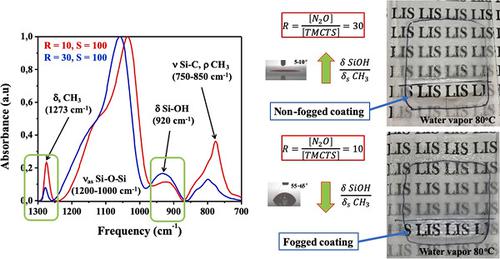当前位置:
X-MOL 学术
›
Plasma Processes Polym.
›
论文详情
Our official English website, www.x-mol.net, welcomes your feedback! (Note: you will need to create a separate account there.)
Atmospheric pressure Townsend discharges as a promising tool for the one‐step deposition of antifogging coatings from N2O/TMCTS mixtures
Plasma Processes and Polymers ( IF 3.5 ) Pub Date : 2020-02-13 , DOI: 10.1002/ppap.201900186 Iván Rodríguez Durán 1, 2 , Antoine Durocher‐Jean 3 , Jacopo Profili 3 , Luc Stafford 3 , Gaétan Laroche 1, 2
Plasma Processes and Polymers ( IF 3.5 ) Pub Date : 2020-02-13 , DOI: 10.1002/ppap.201900186 Iván Rodríguez Durán 1, 2 , Antoine Durocher‐Jean 3 , Jacopo Profili 3 , Luc Stafford 3 , Gaétan Laroche 1, 2
Affiliation

|
The need to ensuring the “see‐through” property of transparent materials when exposed to sudden temperature changes or very humid conditions has encouraged the development of antifogging strategies, such as the deposition of (super)hydrophilic coatings. However, despite the effectiveness of these coatings in combating the effects of fogging, most of the coating techniques explored to date are typically time‐consuming and environment‐unfriendly. Bearing this in mind, we demonstrate that the application of dielectric barrier discharges operated at atmospheric pressure proves to be successful in preparing antifogging coatings on glass samples from 1,3,5,7‐tetramethylcyclotetrasiloxane (TMCTS) and nitrous oxide (N2O). The antifogging performance of the coatings was found to be governed by the [N2O]/[TMCTS] ratio and not by the [N2O] + [TMCTS] sum. Coatings prepared under a [N2O]/[TMCTS] = 30 were superhydrophilic (water contact angles ≈ 5°–10°) due to surface silanol groups and endowed glass samples with a superior antifogging property, as revealed by the ASTM F 659‐06 test. In contrast, because of the lesser hydrophilicity (water contact angles ≈ 60°), coatings prepared under a [N2O]/[TMCTS] = 10 did not endow glass samples with antifogging property. Regardless of the deposition conditions, the plasma‐deposited coatings displayed crack‐free smooth surfaces (Rrms = 2−4 nm).
中文翻译:

大气压Townsend放电是从N2O / TMCTS混合物一步沉积防雾涂层的有前途的工具
当暴露于突然的温度变化或非常潮湿的环境中时,需要确保透明材料的“透视”特性,这鼓励了防雾策略的发展,例如(超)亲水涂层的沉积。然而,尽管这些涂层在抵抗起雾效果方面是有效的,但迄今为止探索的大多数涂层技术通常都是耗时且对环境不利的。牢记这一点,我们证明了在大气压下应用电介质阻挡层放电被证明可以成功地在玻璃样品上制备由1,3,5,7-四甲基环四硅氧烷(TMCTS)和一氧化二氮(N 2 O)制成的防雾涂层。发现涂料的防雾性能受[N 2O] / [TMCTS]比,而不是[N 2 O] + [TMCTS]之和。[N 2 O] / [TMCTS] = 30下制备的涂层具有超亲水性(水接触角≈5°–10°),这归因于表面硅烷醇基团和赋予玻璃样品的优异防雾性能,如ASTM F 659所示‐06测试。相反,由于亲水性较小(水接触角≈60 °),在[N 2 O] / [TMCTS] = 10下制备的涂层没有赋予玻璃样品以防雾性。无论沉积条件如何,等离子体沉积的涂层均显示出无裂纹的光滑表面(R rms = 2-4 nm)。
更新日期:2020-02-13
中文翻译:

大气压Townsend放电是从N2O / TMCTS混合物一步沉积防雾涂层的有前途的工具
当暴露于突然的温度变化或非常潮湿的环境中时,需要确保透明材料的“透视”特性,这鼓励了防雾策略的发展,例如(超)亲水涂层的沉积。然而,尽管这些涂层在抵抗起雾效果方面是有效的,但迄今为止探索的大多数涂层技术通常都是耗时且对环境不利的。牢记这一点,我们证明了在大气压下应用电介质阻挡层放电被证明可以成功地在玻璃样品上制备由1,3,5,7-四甲基环四硅氧烷(TMCTS)和一氧化二氮(N 2 O)制成的防雾涂层。发现涂料的防雾性能受[N 2O] / [TMCTS]比,而不是[N 2 O] + [TMCTS]之和。[N 2 O] / [TMCTS] = 30下制备的涂层具有超亲水性(水接触角≈5°–10°),这归因于表面硅烷醇基团和赋予玻璃样品的优异防雾性能,如ASTM F 659所示‐06测试。相反,由于亲水性较小(水接触角≈60 °),在[N 2 O] / [TMCTS] = 10下制备的涂层没有赋予玻璃样品以防雾性。无论沉积条件如何,等离子体沉积的涂层均显示出无裂纹的光滑表面(R rms = 2-4 nm)。



























 京公网安备 11010802027423号
京公网安备 11010802027423号